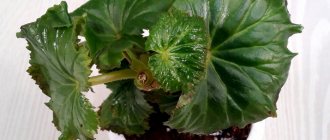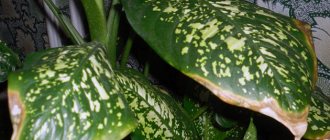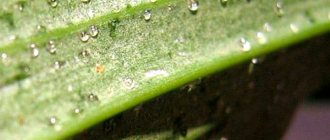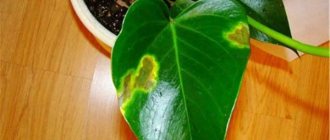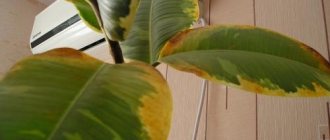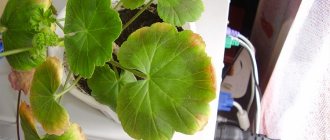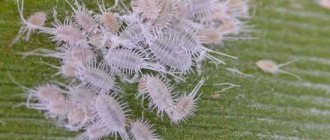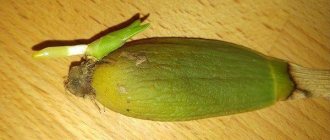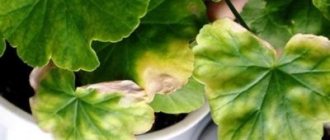A characteristic feature of begonia is its varied color range. An amazingly beautiful flower is considered indoors, but under certain conditions it grows outdoors. Like any ornamental plant, it requires careful care and attention. Often, for no apparent reason, begonia leaves begin to curl and dry out.
There are several explanations for this:
- improper care, non-compliance with watering conditions;
- inappropriate temperature;
- lack or excess of fertilizers;
- illness;
- pests
The plant is unpretentious, but for full growth and active flowering it requires a special approach and attention.
Care: soil, watering, temperature conditions
When begonia leaves dry, it is necessary to determine the cause, choose methods, means and methods of elimination.
- Selection of capacity. Pots should be chosen low but spacious; there should be enough space for the root system. Preference is given to ceramic containers: they allow air to pass through. Before use, they are soaked in water for several hours. If the container has already been used, be sure to thoroughly rinse, disinfect and dry it.
- Temperature changes. Reacts sharply to sudden changes in temperature and does not like drafts. This can happen when you turn on the air conditioner, heater, or move the pot from a warm room to a loggia or balcony. When the first signs of wilting appear, it is worth returning it to its previous “place of residence” and monitoring the room temperature. From October to January, when they are at rest, they are moved to a cooler place, but the air temperature should not be lower than 12 degrees.
- Watering. It is recommended to use settled or filtered warm water; under no circumstances should you water with cold tap water. Add a small amount of lemon juice or citric acid to it. Watering is carried out twice a week in hot weather and once in winter. It is advisable to carry out the procedure at the same time. Ensure good drainage so that water does not stagnate. Over-wetting the soil is unacceptable.
- Priming. The soil mixture is purchased in specialized stores or prepared independently from peat, compost, sand, and leaf soil. The main requirement is that the soil should not have a high level of acidity.
Advice! What to do if the leaves of a begonia dry when grown outdoors? In dry weather, spray them with water 2-3 times a week, build a shelter from direct sunlight.
The problem may be dry indoor air. In such cases, place containers with water and carry out regular spraying. Or they place the pots on trays with sand and pebbles, which are periodically moistened.
Preventive measures
Begonia loves warmth and humidity. Despite the fact that she was born in hot countries, direct sunlight kills her. It is better to place it where there is no bright light, but there is always a stable temperature and humidity of at least 60%. In addition to comfortable conditions, in order to avoid drying out and diseases, begonias need regular feeding, about 3 times a month; liquid complex fertilizers or potassium nitrate are suitable for this. And don’t forget about the usual but constant watering regime.
We invite you to watch a video about caring for begonias:
Top dressing
Begonia leaves curl and dry when grown on depleted soils and lack of mineral and organic fertilizers. Feeding is carried out twice a month, from March to September. It is necessary to follow some feeding rules:
- spend only in the evenings;
- before fertilizing, moisten the soil 2-3 hours before the procedure;
- strictly follow the instructions: oversaturation will lead to oppression and death of the flower;
- Do not allow solutions to come into contact with leaf plates.
Preference should be given to complex fertilizers, which are recommended to be purchased in specialized stores. Consult with professionals, study the method of use and dosage. Experienced flower growers prefer to use proven and reliable preparations.
- "Begonia". Saturates with phosphorus, potassium, microelements.
- "Bona Forte". A broad-spectrum drug. Provides protection from harmful environmental influences and helps fight stress. Saturates with nitrogen, humic acid, phosphorus, and other useful substances.
- "Good Power" It is an excellent growth stimulator, a source of succinic acid, vitamins, and microelements. Stabilizes and accelerates flowering and bud formation. Used as a prophylactic against diseases.
Reference! Ammonium nitrate has a beneficial effect in small quantities.
To understand why the leaves of indoor begonia dry out, you should make sure that it receives a sufficient amount of the necessary fertilizers. Active growth and flowering is ensured if the basic feeding requirements are met.
Leaves fall - diseases and pests
If, as a result of a begonia disease, the leaves wither at the edges, there is no doubt that the next stage will be their falling off. The same fate awaits the buds (if the plant is ornamental), so caring for the flower should be careful.
Why do hydrangea leaves turn yellow and the edges dry out - causes and treatment
First of all, do not allow moisture to get on the foliage and buds! Whitened leaves and fallen buds signal depletion of the soil - mineral fertilizers are needed. It is best to alternate them with organic ones so that the care is comprehensive.
Before you think about what to do if your begonia leaves fall, you need to understand the reason. Most often this is a consequence of fungal infections - high temperatures and humidity create all the conditions for pests. Powdery mildew and gray mold, if not treated, will lead to loss of buds.
The greenhouse whitefly multiplies very quickly and destroys begonia foliage. It sucks out the juices, and the damaged leaves dry out and fall off. If a pest has already settled on a still fresh leaf, it needs to be cut off. Treatment of the affected plant is carried out using insecticides.
Important! During treatment of the affected plant, it must be isolated from healthy specimens.
Nematodes settle on the entire plant, giving greater preference to the lower tiers of foliage. They reveal their presence as brown spots (light green at first) and swellings. An excellent preventive measure against them is steaming the soil.
Pests
When asking the question: “Why do begonia leaves dry at the edges?”, you should carefully examine it for presence or damage by pests.
- Greenhouse aphid. If measures are not taken, the plant will die in a short time; pests multiply at lightning speed, sucking out the juice. The drugs “Fufanon” and “Aktellik” are used for control. Spray with a solution of laundry soap.
- The false shield is soft. Settling inside the shoots, it stops growth. The appearance of this pest may serve as an answer to the question: “Why do begonia flowers and leaves dry out?” Clean them manually with a soft brush and spray with garlic infusion.
- Greenhouse whitefly. When affected, the plants dry out, first changing color. When the first symptoms appear, it is necessary to completely get rid of the problem in a short time. A soap solution helps fight (add 10 g of liquid soap to 2.5 liters of water). Do not allow excess product to get under the roots.
It is important to make sure that you do not introduce pests with the soil you prepared yourself. Therefore, when using a homemade soil mixture, it must be treated using insecticides and heat treated.
Reference! To disinfect the soil, it is calcined in the oven and treated with a solution of potassium permanganate.
What to do if a houseplant has dried out?
If the begonia has dried out completely, both leaves and flowers, you should not throw it away, there is still a chance to save it:
- Check to see if the roots are in order and there are no signs of rotting. Leave only healthy ones and plant them in new soil (the old one will have to be thrown away).
- Cut off all dry leaves and stems.
- Cover the pot with film or a bag.
- Place in optimal conditions and do not forget to feed.
If everything is done correctly, then soon the begonia will delight you again.
There is no need to panic if several of the lower leaves of a begonia have dried out; this is a natural process of development ; old ones die and new ones appear. But if the problem is serious, follow simple rules and maintain optimal comfortable conditions: light, humidity, temperature, standard complex fertilizers, and the plant will recover.
Caring for begonia is not difficult; it is suitable for even the most inexperienced novice gardeners. It is no coincidence that she is so loved in our country. Begonia purifies the air, has a beneficial effect on the immune system, and does not cause allergies.
Diseases
The flower is affected by a disease - this is why begonia leaves dry at the edges and subsequently fall off. Such troubles happen for several reasons that need to be clarified and eliminated as soon as possible.
- Downy mildew. The first sign is a whitish coating. After a short time, the tips of the leaves dry out and crumble. In the early stages, the fungicides “Fundazol” and “Moristan” are effective. For preventive purposes, spray with a solution of copper sulfate and laundry soap.
- Bacterial spotting. The plant becomes covered with brown watery spots, the inflorescences turn black. The soil is disinfected with special chemicals. For prevention, treat with copper oxychloride.
- Gray rot. Fungal infection is identified by a characteristic fluffy gray coating. Gradually the entire plant dies. It is treated with tincture of ash and potassium permanganate, treated with fungicides “Topaz”, “Fundazol”, “Topsin-M” when the first symptoms appear.
Advice! When the first signs of disease appear, it is necessary to take emergency measures and treat the plant and soil with special preparations.
When begonia leaves curl and dry outside, the cause may be: insufficient watering, heavy rainfall, sunburn, accumulation of dust and dirt. This also happens in the case of dense plantings: the distance between bushes should not be less than 50 cm.
Indoor begonia: causes of drying and falling leaves
Potted begonia dies, leaves dry out and fall off due to:
- drafts from windows open in spring;
- exposure to direct ultraviolet rays, causing burns to the plant while on a loggia or a sunny southern window;
- dry air in winter due to the operation of heating devices and batteries;
- lack of fertilizers or an incorrectly selected complex for feeding begonias;
- damage from pests;
- diseases with a sharp change in growth conditions;
- stress due to neglect and poor water chemistry.
It is important to know why begonia in a pot withers when feeding: there may be an excess of nitrogen. Flowers and buds dry out and later fall off after spraying them with water. Drops of water should not fall on the buds or deep into the flowers.
Prevention
In order not to look for the reasons why begonia leaves dry at the edges, it is necessary to periodically adhere to the basic principles and carry out preventive treatments.
- Carefully select the soil and treat it before planting.
- Avoid stagnation of water when watering.
- Loosen the soil regularly.
- Provide comprehensive fertilizing throughout the entire growing season.
- Promptly remove damaged and diseased leaves and inflorescences.
- Do not place pots near radiators, stoves, air conditioners and heaters.
- Maintain the air temperature within 12 - 20 degrees.
- When planting, place the tubers in containers shallowly so that the apical buds are visible, and add soil as they grow and take root.
Reference! Begonia does not tolerate moving from place to place; the plant tolerates stress.
The effective remedies “Epin” and “Zircon” are used as a growth stimulant and as a stress reliever. When transferring from a smaller pot to a larger one, you must carefully handle the root system. Damage to the roots will soon lead to disease and possibly death. Only timely measures taken will avoid irreversible consequences.
Basic rules for growing and caring for begonia
Caring for this indoor flower is not difficult at all, even for beginners. It is suitable for room temperatures. In summer, the optimal temperature range will be +15...+20°C, and in winter closer to +15°C. Begonias do not like direct sunlight, so they should be kept on windows facing west or east. In winter, they should be moved away from heating devices, protected from drafts and sudden temperature changes. The soil should not be allowed to dry out, but waterlogging should also be avoided, as it leads to rotting of the plant.
Important! Begonia does not tolerate dry air and needs to maintain its humidity at least 60%.
Causes of plant disease
- Changes of residence.
- The plant was exposed to a draft for a long time.
- Sudden changes in temperature and humidity conditions in the room.
- They transplanted it immediately after purchase, thereby the plant suffered stress.
- Unsuitable flowerpot.
- During planting, the soil was not used; it may be acidic or heavy.
- Liquid got on the foliage.
- The cause may also be pests such as aphids, whiteflies, and spider mites.
- The plant may become sick due to fungal or bacterial infection. In which watery brown spots, or a white coating and yellow spots appear on the leaves of the plant.
When improper care is to blame
Begonia is considered a capricious plant. The flower requires constant attention and care. In their absence, he begins to get sick. Timely changes in maintenance conditions will help save the plant from death.
Appearance of the plant with proper care
The main problems caused by errors in care:
- Sudden stretching of shoots - occurs due to improper lighting, when transplanting into a cramped container or lack of microelements.
- A sticky coating on the leaves appears during the initial stage of flower rotting. The main reasons are waterlogging of the soil and increased levels of humidity in the room. You can cure a flower by removing the affected parts and adjusting the watering and lighting regime. Recovery is also facilitated by treatment with a solution of Euparen, Fundazol or Topsin.
- Begonia stops growing - this is caused by waterlogging of the soil. Changing the soil and significantly reducing watering will help restore development.
- Reddening of the leaf blade in spring is most often due to an excess of light.
- Powdery mildew infection is also caused by errors in care. Reducing watering, reducing indoor humidity, increasing the temperature and completely eliminating drafts will help save the situation.
- The appearance of false scale insects on a flower is caused by a draft or the presence of an infected plant near the begonia. The insect lives inside the stems and ultimately leads to the death of the entire bush. When the first signs of infection appear, it is necessary to manually treat the affected areas with an infusion of garlic or onion. The operation is carried out until it is possible to completely get rid of the insects.
- The appearance of whiteflies, which multiply very quickly, is the result of improper care and non-compliance with the rules of basic agricultural technology. You can save the flower if you treat it with a strong soap solution. Every damaged leaf must be destroyed immediately. Sprinkling with a soap solution is carried out until all pests disappear.
On a note! Stopping the growth of begonia is sometimes caused by a period of dormancy. In spring, flower development will resume.
Interesting Facts
- Begonia tubers can be eaten and have a citrusy flavor.
- This flower is a state symbol in North Korea - it can even be seen on the flag of this country.
- The seeds of the plant break all world records in size. From a bag weighing 30 grams, you can get about 3,000,000 sprouts.
- In ancient times, Begonias were used to polish sword blades.
- One of the main beneficial properties of the flower is the ability to purify the air and increase immunity. Therefore, Begonia is often placed in rooms where there are children. especially allergy sufferers.
We wrote everything about whether it is possible to keep begonia in the house, and read about the beneficial and harmful properties of this plant for the home and people here.
I hope that after reading this article you are finally convinced that the plant described is ideal for novice gardeners and busy people. After all, caring for the Imperial Flower does not take much time and is not difficult. So, go for it!
Leaves turn yellow and dry and curl at the edges
Reasons for indoor plants
- The plant finds itself in an environment that is unusual for it . For example, with the onset of spring, vents and windows are opened in apartments, and a draft appears in the apartment, which begonia really does not like. Or, knowing that begonia is a light-loving plant, they put it on the balcony, wanting to please it with sun and warmth. And they achieve the opposite result. A plant that has received stress begins to rebel, the leaves dry out and wither. Solution: Return the flower pot to its usual conditions - on a warm, illuminated windowsill.
- If the leaves dry out and turn yellow in winter, then the culprit is the begonia’s love for a humid environment. Usually grown indoors on window sills, under which steam heating radiators are located. The air in the apartment is dry. Solution: Place the flower pot in another place. If this is not possible, you can place a cup of water nearby. Regular spraying with water will also help.
We humidify the air by spraying , trying not to get it on the plant, especially the buds.
- Lack of microelements. Solution: Pamper with regular fertilizing using complex fertilizers. Or use potassium nitrate.
Reasons for garden plants
- Hot and dry weather, insufficient irrigation . What to do: adjust the water supply. But there is a small nuance here. The roots do not like constant dampness, so you need to make sure that the soil is moist, but well ventilated and not constantly wet.
Features of the flower
Plants of the Begoniaceae genus can be divided into 2 large species:
- decorative deciduous;
- decorative flowering.
The first subspecies has large leaves of various shapes. Their inflorescences are small and unattractive. The appearance of deciduous begonias resembles tropical plants, all kinds of ficus. Flowering varieties, on the contrary, attract attention with multicolored inflorescences. Some varieties bloom for a whole year. You will learn about the types of this wonderful plant in a separate article.
When improper care is to blame
Begonia is considered a capricious plant. The flower requires constant attention and care. In their absence, he begins to get sick. Timely changes in maintenance conditions will help save the plant from death.
Appearance of the plant with proper care
The main problems caused by errors in care:
- Sudden stretching of shoots - occurs due to improper lighting, when transplanting into a cramped container or lack of microelements.
- A sticky coating on the leaves appears during the initial stage of flower rotting. The main reasons are waterlogging of the soil and increased levels of humidity in the room. You can cure a flower by removing the affected parts and adjusting the watering and lighting regime. Recovery is also facilitated by treatment with a solution of Euparen, Fundazol or Topsin.
- Begonia stops growing - this is caused by waterlogging of the soil. Changing the soil and significantly reducing watering will help restore development.
- Reddening of the leaf blade in spring is most often due to an excess of light.
- Powdery mildew infection is also caused by errors in care. Reducing watering, reducing indoor humidity, increasing the temperature and completely eliminating drafts will help save the situation.
- The appearance of false scale insects on a flower is caused by a draft or the presence of an infected plant near the begonia. The insect lives inside the stems and ultimately leads to the death of the entire bush. When the first signs of infection appear, it is necessary to manually treat the affected areas with an infusion of garlic or onion. The operation is carried out until it is possible to completely get rid of the insects.
- The appearance of whiteflies, which multiply very quickly, is the result of improper care and non-compliance with the rules of basic agricultural technology. You can save the flower if you treat it with a strong soap solution. Every damaged leaf must be destroyed immediately. Sprinkling with a soap solution is carried out until all pests disappear.
On a note! Stopping the growth of begonia is sometimes caused by a period of dormancy. In spring, flower development will resume.
How to stop?
If your plant is in a draft, immediately change its location.- During hours of maximum sun activity, create shade or partial shade for Begonia. Or move it to a permanent place on the east or west side of the room.
- Humidify the air. But we do not recommend doing this by spraying. It will be better if you place a container of water near the flowerpot. It is also advised to periodically place a tray with expanded clay under the pot. Sometimes you can get by by simply moving the plant away from radiators that dry out the air.
- A lack of nutrients can be the root of the problem of leaf drying, especially during the period of active growth and flowering of Begonia. Therefore, do not forget to pamper your beauty every ten days. To do this, use complex liquid fertilizers purchased in special stores. Pay attention to the composition of the fertilizer. The percentage of nitrogen content in it should be minimal, as it is not suitable for flowering plants. Read about how to feed begonia for abundant flowering here.
- We will talk about possible diseases and pests separately below.
- A change in temperature, watering regime, lighting, or replanting into a too large pot can cause stress for a flower (read how to choose a pot for begonias and properly care for them in a pot here). Even completely harmless pinching off a sprout can lead to stress. Of course, begonias need to be pruned periodically, and some propagate only by cuttings. But here it is important to know where to “bite off the tidbit.”
- Water for irrigation must be prepared. If you take from the central water supply, let it sit for a day. Better yet, use rainwater to moisten the soil.
